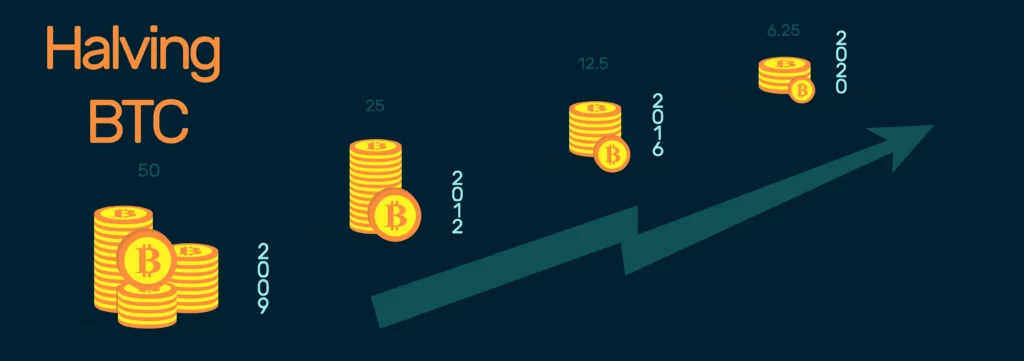There are many inevitable parts of the bitcoin and crypto investing journey. Perhaps the most unpleasant is that any investor in it for the medium-long term will have to learn to navigate significant crashes, both financially and emotionally.
This is, however, balanced out by another historical trend in the market. No matter how drastic the circumstances, there is always the great leveller of price fluctuations: the bitcoin halving cycle.
Since the inception of Satoshi’s project during the aftermath of the 2008 financial crisis, the value of bitcoin (and all crypto by extension) has been regularly propped up every 4 years by what is an essential design feature of the dominant (and pioneering) blockchain token.
Reliance on this phenomenon has kept many invested beyond any momentary weakness and lengthened investing horizons across the whole market for years. But the seismic shift caused by crypto’s rapid growth into both retail and institutional realms during 2020-2021 changed many established dynamics regulating price, and a few voices have boldly announced the halving cycle’s influence as decaying and possibly already broken.
What Is The Halving Cycle?

Despite the widespread uncertainty and hesitant mood in the cryptosphere and macroeconomics alike, there is one certainty. Come rain or shine, peace or war, inflation or recession… the next bitcoin halving will take place sometime in early May 2024.
At the time of writing, this is exactly in around 630 days, or just under two years. There’s even a countdown clock for it. But what is this date decided by, and what does the halving actually mean?
The halving process is a core feature of Bitcoin, and its value as a digital ledger with verifiable and reliable programmed scarcity. The concepts aren’t complicated: the coin can’t be minted endlessly, and is by design limited to a total of 210 million in circulation. Once this number is reached through completion of all mining processes (estimated to be around the year 2140), there won’t be any more bitcoins created, ever. This makes it a valuable financial tool, as it’s a feature that isn’t shared by FIAT currencies.
Until this date far into the next century, the process of mining new coins is regulated by a mechanism that periodically halves the amount of bitcoins generated through mining, and in turn also halves the rewards received by miners for doing so. This tends to happen every 210,000 blocks mined or so, which is an event regularly occurring around every 4 years.
This mechanism is the key of its intended use as a hedge against inflation, although this concept has had its criticism lately due to an ever-increasing correlation between high-risk tech stocks and crypto prices. With such a sharp and sudden decrease in output and therefore availability of coins, but assuming a stable or (as has been the case historically so far) increasing demand, this is a surefire way to hold off inflation. BTC’s inflation rate was at a staggering 50% in 2011, but has since dropped all the way down to 1.77% today.
The cycle of changing rewards and artificial scarcity can be easily visualised through this brilliant Reddit post, and it has led to block rewards (meaning the amount of bitcoin each mined block earns the corresponding miner) dropping from 25 to 12.5 in 2016 and from 12.5 to 6.25. In 2024, this will again be slashed down to 3.125. In 2140 (or around then), when the process is completed, rewards will cease to be generated by mining and will instead shift to transaction verification, in a manner not too dissimilar from how credit card companies operate.
Why Does It Matter?

Affecting the rewards, which represent by large the main source of profit for any mining outfit on the globe, represents a sure-fire way to quickly change strategic approaches for the entire sector.
Smaller rewards require more mining efficiency to achieve the same profits, as well as providing a further push for upward price movement due to the higher costs incurred by miners to make their mining operations more effective.
This, coupled with the aforementioned combinations of lower supply and historic trends of constant or increasing demand has led to a pretty regular occurrence: when rewards are halved, BTC price jumps up for several months and it drags the entire crypto industry with it. These bull-runs usually reach their apex or ATH around half-way through the cycle, and then recede into a downward slide, only for the whole process to restart.
At the first halving in 2012, price was hovering around $12 and it subsequently led to a bull run which peaked just under $1,000 per BTC (or a near-8000% jump up). At the second halving in 2016, price had reached $650 and it would go on to a famous ATH of $19.5k. The last halving, which happened right after the 2020 COVID-fuelled stocks and crypto crash, saw BTC enter the new reward era at $8.7k and pump all the way to $66k, before beginning a classic yet drastic slide in the first half of 2022.
Though of course the % run up caused by each ‘halvening’ has heavily reduced when compared to the 2012-2016 cycle, that is only natural. These numbers are certainly encouraging for any long term investors, or at least they have been until now.
During the last bull-run, many have begun theorising that this cycle might be on the verge of breaking down. There are concerns that the demand and adoption growth rates seen during the recent bull periods might not be sustainable, and that the entrance of institutional money in the space might impact supply circulation and manipulate it into less volatile peaks and valleys in the price chart.
Despite this, the crypto industry remains in the very early stages of development according to many insiders, and adoption is poised to grow further into the next decade – thus providing continuous demand as is needed for the cycle to remain active.
Preparing For The Halving

No matter which specific cryptocurrency investors dip their feet in, it will be impacted by the halving more or less directly. BTC still dominates the sector and the calls for a ‘flippening’ event in 2021 were very much false alerts. For the foreseeable future, its price will continue to drive investment to the crypto space and function as a health tracker for the industry as a whole.
In this light, it is not required or advisable for investors to specifically switch their portfolio to be more BTC-exposed, as such exposure will happen organically regardless of the specific token they hold.
As the bull-runs that follow halvings aren’t triggered exactly on the day of the halving but can start at any point before or after the key date (currently May 4, 2024) due to the event being priced in, it is risky to try and time the market. Not that it ever isn’t!
A sensible strategy would be to continue to dollar-cost-average one’s investment into their chosen blockchain projects throughout the next two years, perhaps increasing contributions as the event gets closer.
Bitcoin and crypto as a whole are currently oversold and the sentiment in the market is hardly positive. This does not sound too appealing at first glance, but it does signal we might be around the bottom of the current cycle – presenting us with the perfect moment to commence accumulating.
If historical trends are followed, the next lift-off in terms of price would occur around 2025. This date seems distant enough that the current recession might have come and passed, the war in Russia might have found an hopefully peaceful resolution and the global economy be finally free of the COVID-19 fallout. A halving event combined with favourable macroeconomic events might present another golden opportunity for all crypto faithfuls.
Just a few thousand blocks to go!









